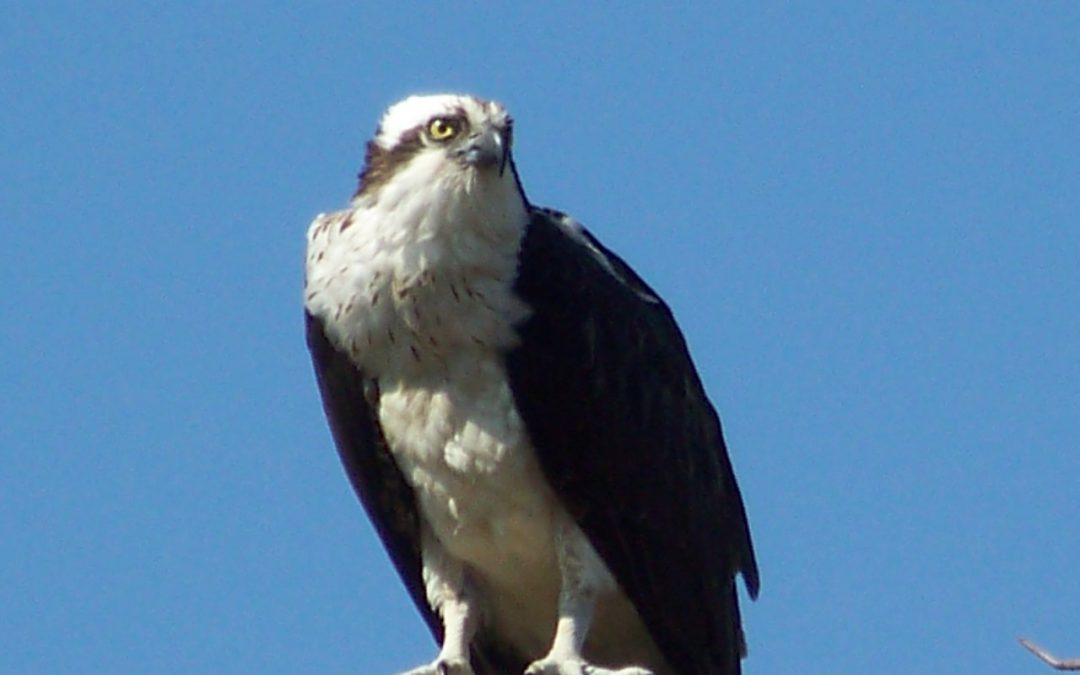
by Carrie Stevenson | Sep 27, 2019
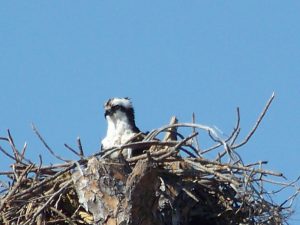
Ospreys, or fish hawks, build their nests from sticks atop dead trees. Photo credit: UF IFAS Extension
Big hurricanes like Dorian (Bahamas) and 2018’s Michael (central Florida Panhandle) were devastating to the communities they landed in. Flooding, wind, rain, loss of power and communications eventually made way for ad hoc clearing and cleanup, temporary shelters, and a slow walk to recovery. Among the most striking visual impacts of a hurricane are the tree losses, as there are unnatural openings in the canopy and light suddenly shines on areas that had been shaded for years. In northwest Florida, pines are particularly vulnerable. After any hurricane in the Panhandle, you can drive down Interstate 10 for miles and see endless pines blown to the ground or broken off at the top. During Hurricane Ivan 15 years ago, the coastal areas in Escambia and Santa Rosa lost thousands of trees not only due to wind, but also to tree roots inundated by saltwater for long periods.
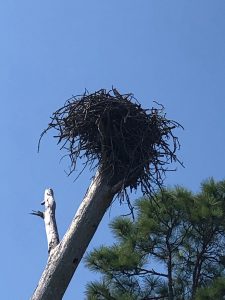
Dead trees left by hurricanes serve as ideal nesting ground for large birds like ospreys. Photo credit: Carrie Stevenson, UF IFAS Extension
Nature always finds a way, though. Because of all those dead (but still-standing) pines, our osprey (Pandion haliaetus) population is in great shape in the Pensacola area. How are these two things related? Well, ospreys build large stick nests in the tall branches/crooks of dead trees, known as snags. They particularly prefer those near the water bodies where they fish. When I first moved here 20 years ago, I rarely saw ospreys. Now, it’s uncommon not to see them near the bayous and bays, or to hear their high-pitched calls as they swoop and dive for fish.
If you are not familiar with ospreys, they can be distinguished by their call and their size (up to six foot wingspan). It is common to see them in their large nests atop those snags, flying, or diving for fish. I usually see them with mullet in their talons, although they also prey on catfish, spotted trout, and other smaller species. They have white underbellies, brown backs, and are smaller than eagles but larger than your average hawk. One of their more interesting physical adaptations (and identifying characteristics) is their ability to grip fish parallel to their bodies, making it more aerodynamic than the perpendicular method most birds use.
Ospreys mate for life, and cooperate to build nests and care for young. The species has overcome many complex threats—including DDT damage to eggs and habitat loss—but the sight of them flying is always inspiring to me. They are a living embodiment of resilience amidst adversity.
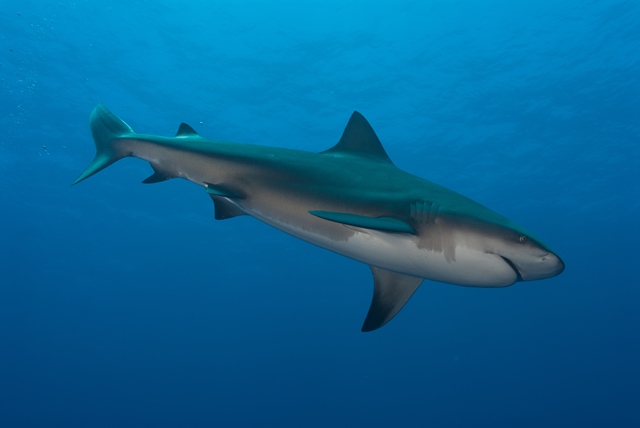
by Rick O'Connor | Jun 28, 2019
The recent attacks on swimmers in North Carolina have once again brought up the topic of sharks. And of course, “Shark Week” is coming up. It is understandable why people are concerned about swimming in waters were animals weighing several hundred pounds with rows of sharp, sometimes serrated, teeth are lurking. It is also understandable that local tourism groups are concerned that visitors are concerned. Sounds like the movie Jaws all over again.
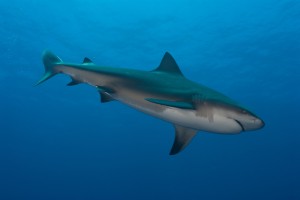
The Bull Shark is considered one of the more dangerous sharks in the Gulf. This fish can enter freshwater but rarely swims far upstream. Photo: Florida Sea Grant
So, what is the risk?
It is good question to ask for anything we feel uncomfortable with. Hiking in Rockies where bears might roam. Hiking in wetlands of Florida or deserts of the American southwest where venomous snakes may lurk. Paddling the creeks and rivers of the American southeast where alligators could be basking. All are concerns.
According to G. Tyler Miller and Scott E. Spoolman, a risk is the probability of suffering harm from a hazard that can cause injury, disease, death, economic loss, or damage. There is a difference between possibility and probability. There is always the possibility of a shark attack, but what is the probability it will happen? Unfortunately, media blast can create a scare over a highly unlikely possibility without discussing the data driven probability of it happening. We all take risk every day – riding in a car, smoking, drinking alcohol, eating bad food – which can lead to heart issues and the number one killer of humans worldwide, and more. Many of these we do not consider risky. We feel we are in control, understand the risk, and are managing from them. Those risk we have little control over – shark attacks – seem more of a risk than they really are. The car is far more dangerous, yet we do not hesitate to get in one at zoom onto the interstate.
Let’s conduct a simple risk assessment of shark attacks…
What is the hazard of concern?
Being attacked by a shark
Dying from the shark attack
How likely is the event?
The International Shark Attack File was first developed after World War II to address the issue of shark attacks on US Navy personnel, but expended to everyone. It was originally housed at the Smithsonian Institute but is currently housed at the Florida Museum of Natural History in Gainesville. Based on their records of unprovoked shark attacks (the ones we are truly interested in) there have been 3103 attacks on humans since 1580. 46% of those were in the United States, ranking us #1. Number two and three are Australia and South Africa. So as far as nations go, we are number one for attacks. However, this equates to 7 attacks / year – worldwide. And not all of those died. Most did not.
Which state?
Since 1837, 828 attacks (57%) occurred in Florida. This equates to 4.5 attacks / year. Florida is number one, followed by Hawaii and California.
What about counties in Florida?
Since 1882 there have been 303 attacks (36%) in Volusia County. This equates to 2.2 attacks/year. The total number of attacks in Florida panhandle counties since 1882 have been 25 – this is 0.2 attacks/year for the entire panhandle.
What were these Floridians and visitors doing when they were attacked?
Surface recreation (surfing, boogie boarding), swimming, and wading top the list, the other activities were logged.
So, there have between 8-10 shark attacks each year, and two fatalities, worldwide.
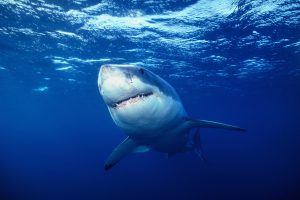
The white shark is responsible for more attacks on humans than any other species. It is found in the Gulf of Mexico in the winter months but there are no reports of attacks in Florida.
Photo courtesy of UF IFAS
The Risk Assessment is used to develop a Risk Management Plan
First, How do these shark attack data compare with other risks?
I wondered how many car accidents occur each year worldwide?
According to USA Insurance Coverage, who got their data from the National Highway Traffic Administration – 5,250,000 each year in the United States alone. About one every 60 seconds.
Situations that cause human deaths annually in the United States
Heart disease 652,486 1 in 5 people
Cancer 553,888 1 in 7
Stroke 150,074 1 in 24
Shark attack 1 1 in 3,748,067
Between 1992-2000 there were 2 shark attacks in Florida. In that same time period, there were 135 drownings.
Between 2004 and 2013, 361 people drowned in rip currents. During that same period, 8 people were attacked by sharks.
Between 1990 and 2009, in Florida, 112,581 people were involved in bicycle accidents; 2272 died. In that same period, there were 435 shark attacks in Florida; 4 died.
And my favorite…
Between 1984 and 1987, 6339 people had to visit a hospital in New York City because they were bitten by a human. This was 1585 / year. In that same period there were 45 shark attacks in the entire United States. This was 11 / year.
Second, How should we reduce the risk of shark attack?
Well… as you can see from the assessment and comparative risk analysis, many would say you did not need to develop a plan to reduce risk because the risk is too low to fool with. You should spend time on hazards that are of a more real concern. That said, there are some things you can do.
– Avoid excessive splashing; it is known that sharks are attracted to this. It is also known that more often than not, they move away when they detect the source of the splashing.
– Avoid swimming when bleeding or in water with strong smells (like fish bait); this too will attract them.
– Most unprovoked attacks occur between 11:00 AM and 3:00 PM. But honestly, that is when most people are in the water. This could be different if most of us swim after sunset. That said, we recommend that you reduce swimming at dawn and dusk.
I hope this clear up some of the concerns about shark attacks. Yes, they do happen – but infrequently. There are some things you can do to reduce your risk, but these should not keep you from enjoying water related activities. Enjoy your time here on the Gulf coast. Be careful driving and try to eat healthier.
References
International Shark Attack File. https://www.floridamuseum.ufl.edu/shark-attacks/.
Miller, G.T., S.E. Spoolman. 2011. Living in the Environment. 16th Edition. Brooks and Cole, Cengage Learning. Belmont CA. pp. 121.
USA Insurance. https://www.usacoverage.com/auto-insurance/how-many-driving-accidents-occur-each-year.html.
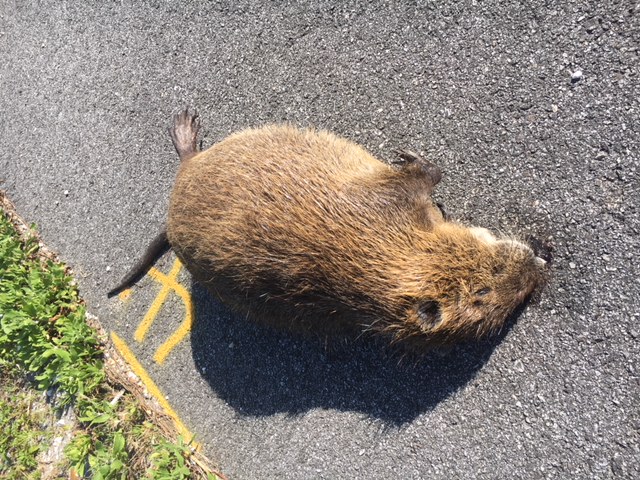
by Rick O'Connor | Jun 28, 2019
I found one in Escambia County, near Perdido Key. It was dead, roadkill, and was quite large. Needless to say, working with invasive species and trying to stay ahead of any new potential problems, I was surprised. I immediately turned around to confirm what I saw as I drove by – it was a nutria.
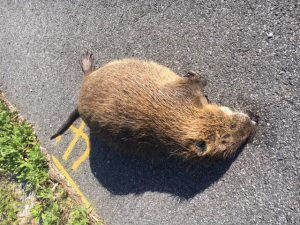
A dead nutria found along a roadside in Escambia County.
Photo: Rick O’Connor
Many of us have heard of this large rodent (Myocastor coypus), and all the problems it has caused in the state of Louisiana. With the loss of their marshes at stake, it was “all hands” to battle this guy. From reading, it appears it was released across the United States as a potential fur product. I found statements that they may have been brought here from their home in South America as early as the 19th century. Certainly, by the 1920s and 1930s they were here. Today there are records in 18 states across the southeast, the Chesapeake Bay area, and the Pacific northwest – a widespread release and distribution.
It is another classic invasive species story. A nonnative creature is brought to the United States for some specific reason, sometimes accidentally; escapes into the local environment, or is intentionally released; has no natural predators so begins to reproduce at a high rate; and causes environmental and/or economic problems. The United States spends hundreds of millions of each year battling such species.
In the nutria’s case, it is from South America. It was hard to determine whether they were brought over here in small increments to different locations over time, or whether they were brought here in bulk and released into habitats they could survive in, but they were released. It is a large rodent and resembles a beaver except that its tail is round, and not flat, and the profile of their back has an arch to it. They can reach two feet in length, not counting tail, and can weigh up to 20 pounds.
They are herbivores, and some used this animal to control aquatic plants in their ponds. Like many rodents, they have an aggressive reproductive rate to overcoming predation. Nutria become sexually mature within 4-6 months and can produce their first litter at eight months. They breed year-round and typically have three litters / year with 2-13 young / litter. Gestation is 128-130 days and the females are ready to breed within 48 hours of birth.
Nutria like water and can survive in brackish conditions. They live in small social groups that typically have a dominant male, 2-3 females, and the young. Activity is usually at night, moving through the habitat consuming 25% of their body weight in plants each day. They can be seen during daylight hours if food is scarce.
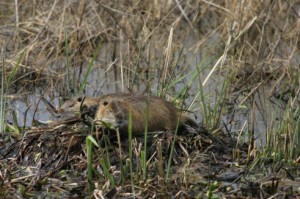
Photo Courtesy of US Fish & Wildlife National Digital Library
So, what’s the problem?
They eat a lot and burrow for denning. Many waterways are endangered due to their destructive habits. The tunneling and burrowing can compromise the integrity of banks and shorelines around these waterways. Louisiana, being a state with many levees holding water back from communities, you can understand their concern; but communities in Washington, Oregon, and Maryland are facing the same issues. They are carries of certain pathogens and parasites, such as tuberculosis, septicemia, and liver flukes which can be a threat to humans and pets. They also carry nematodes which can trigger a condition known as “nutria itch” in waterways where they are found.
In 1938, 20 nutria were released in Louisiana. By 1958 there were 20 million in the state. There did not seem to be any natural control and the state began losing its marshes. The interesting thing is there are records of releases in Florida as far back as 1955. There are records of this animal in the Pensacola area dating back to 1956. Yet, we do not see the overwhelming numbers found in Louisiana, or with lionfish in our area. I spoke with long time Mobile Delta natural historian Jimbo Meador about the problem there. He said there were lots of nutria at one time and they had hunting tournaments to control them. But when the state began protecting alligators the nutria problem went away – a natural predator after all. He said today you can still find nutria in the Mobile area, but they are restricted to the more brackish areas where alligators are not as common.
Which brings us back to the Pensacola issue.
Many believe that the best method for controlling a new potential invasive species is discover and manage them early before they become widespread and established. Even though this is the first one I have seen in Escambia County, they apparently have been in the area for over 60 years. Something seems to be controlling their populations, which is a good thing. That said, any populations found should be monitored so they do not become more widespread. Currently, the Florida Fish and Wildlife Conservation Commission considers them as one of the furbearers and manages them as such. Live trapping is allowed but you must have a trapping permit to do so. You can actually sell the fur, but you will need a license for this. This may be like the tiger shrimp story, an invasive we are aware of but is not becoming a widespread problem in the county, but I do recommend anyone seeing the creature report to the website data base www.EDDMapS.org so that we can all keep track of where they are and whether they are spreading.
References
California’s Invaders: Nutria (Myocastor coypus), California Department of Fish and Wildlife
https://www.wildlife.ca.gov/Conservation/Invasives/Species/Nutria.
Jimbo Meador (personal communication)
Maryland Mammals: Nutria (Mycastor coypus), Maryland Department of Natural Resources
http://dnr.maryland.gov/wildlife/Pages/plants_wildlife/Nutria.aspx.
Nutria Biology and Identification, Chesapeake Bay Nutria Eradication Project, U.S. Fish and Wildlife
https://www.fws.gov/chesapeakenutriaproject/Biology.html.
Nutria (Myocastor coypus), Florida’s Nonnative Wildlife Species Detail, Florida Fish and Wildlife Conservation Commission.
https://myfwc.com/wildlifehabitats/nonnatives/mammals/rodents/nutria/.
USGS, Nonindigenous Aquatic Species, Nutria (Myocastor coypus)
https://nas.er.usgs.gov/queries/FactSheet.aspx?speciesID=1089.
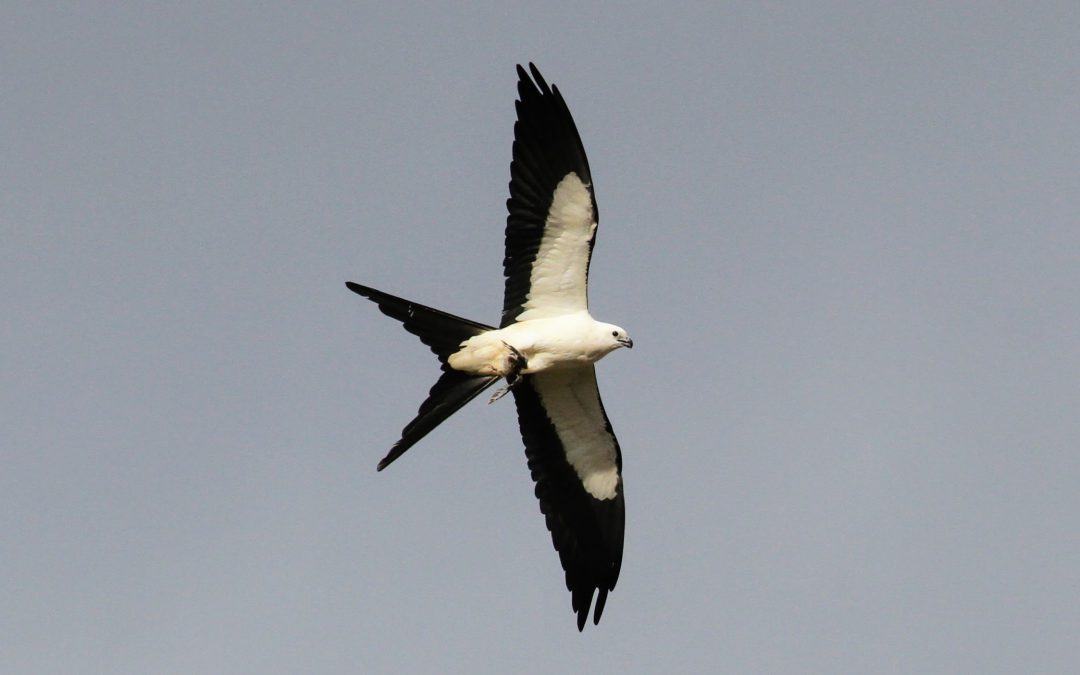
by Erik Lovestrand | Jun 21, 2019
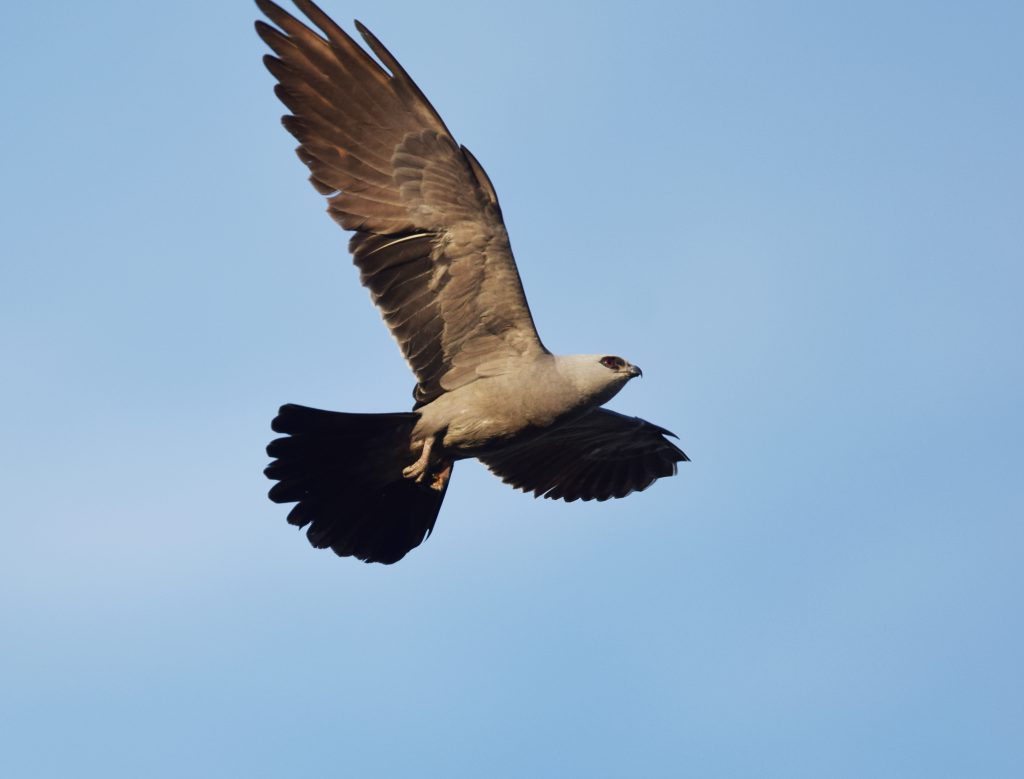
Mississippi kites are smaller but impressive aerialists as well. Photo by Andy Reago, Flickr Creative Commons.
Dime store kites were never very expensive, but it still seemed like a luxury when I was growing up and it was a rare thing for us kids to see a store-bought kite flying over our neighborhood. An old paper grocery bag (remember those), some cotton string for the corner loops, and two dog fennel sticks cut from the back field provided the basic ingredients for us to make our own. With a little creative cutting and gluing, and the attachment of a tail made from torn strips from a worn-out shirt, it was a thing of grace and beauty and was soon aloft on the wind. On a good day, with the right breeze (not too light, not too gusty), we could run out two full rolls of kite string until the kite was just a speck in the distance. The real challenge was winding all of that string back in after the kite came down across houses, powerlines and fields.
Please forgive the digression but thinking about the topic for this article sent me on a little trip down memory lane. We are fortunate to have two very interesting avian species of kites that grace our summer skies over North Florida. Both are exceptional aerialists but one of them in particular will leave a visual image that is hard to shake. The swallow-tailed kite (Elanoides forficatus) is one of the most impressive birds on the planet with its stark white belly and under-wing coverts, outlined in bold black trim. Its deeply forked tail gives rise to several descriptive names such as split-tailed hawk and fork-tailed hawk, among others. Each spring, swallow-tailed kites migrate in small groups back to their breeding range that extends into the Florida Peninsula and sections of the Panhandle, including several North Florida counties. I’ve seen up to 21 kites flying over the Apalachicola River floodplain during this time of year. Forested swamp habitats along river corridors are particularly valuable for foraging and nesting areas but these graceful flyers are also observed over agricultural fields and pastures where they catch dragonflies and other bugs on the wing; usually dining in the air. Nesting takes place in treetops and young are fed a mixed bag of insects, tree frogs, lizards and small snakes, most snatched from the treetops in flight. Occasionally, the young of other birds are taken from their nests and added to the menu. After the young have fledged from the nest, it isn’t long before our kites head back to their wintering grounds in South America. Young birds can be identified by their less-deeply forked tail, due to the short outer tail feathers.
The other kite that graces our area during summertime is the Mississippi kite (Ictinia mississippiensis); not quite as flashy as its fork-tailed cousin but beautiful in its own right. Adult Mississippi kites are a pearly gray color with darker wings and tail. They are significantly smaller, with a wingspan of about 3 feet (swallow-tailed kites have a wingspan up to 4.5 feet). Wintering grounds are in South America also but the breeding range in the US includes several western states such as Texas, Oklahoma and even sparsely in New Mexico and Arizona. This species is known to vigorously defend its nest by dive-bombing trespassers who get too close.
I see both species flying around my house in Wakulla County and without fail, I pause to appreciate the grace, beauty and tremendous distances covered during annual flights by these long-distance migrants. Keep looking up during our summer months and you may well be rewarded by a glimpse of these two “kites over North Florida.”
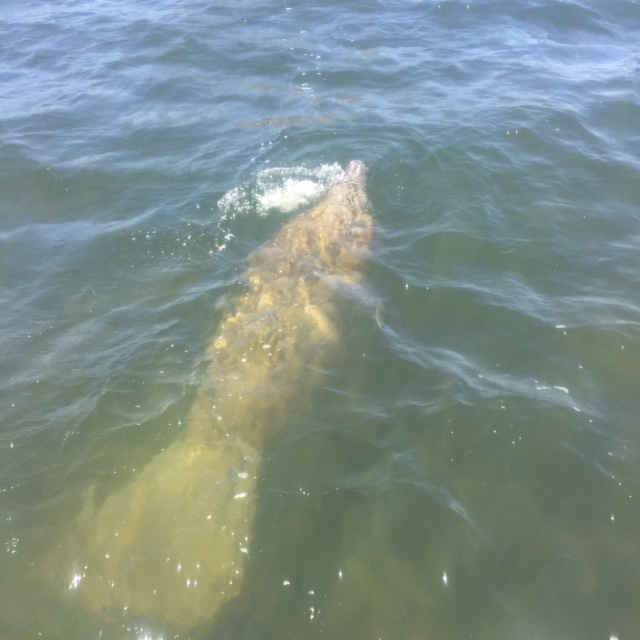
by Rick O'Connor | Jun 7, 2019
This is becoming an annual summer encounter – manatees in (near) the Intracoastal Waterway of Pensacola Bay area. They have been before, it is not uncommon for them to be seen at Palafox Pier Marina, but in the last few years groups of five to nine manatees have been spotted drifting along the shorelines and hanging around docks in Gulf Breeze and the Perdido Key area.
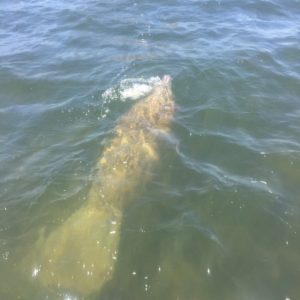
Manatee swimming in Big Lagoon near Pensacola.
Photo: Marsha Stanton
I cannot say what this means but we are not alone with these new visitors along the Gulf coast. There are enough manatee sightings in the lower portions of Mobile Bay that manatee signs have been placed along Magnolia River and a manatee watch hotline has been set up at Dauphin Island Sea Lab. There are at least 40 resident manatees in the Wakulla River. And now, at least in the last two years, small groups have been seen in our area. Concerned whether these manatees were returning to southwest Florida for the winter during the red tide, there were plans to tag some of them – I am not sure if that was done or not.
So, what does this mean for us?
Well, your first thought is the concern over boat strikes. The manatee has actually been protected by Florida law since 1893. Their numbers have increased to 6600 animals and so their status has been changed from endangered to threatened. That said, they are still protected by both the Endangered Species Act and the Marine Mammal Protection Act.
According to an FWC report, in 2018, 824 manatees died in Florida. The top five causes were (1) Natural causes – 27%, (2) Undetermined – 20%, (3) Watercraft – 15%, (4) Perinatal death – 14%, and (5) Unrecovered – 13%.
There were 17 deaths reported from the Florida panhandle. Wakulla (7), Franklin and Escambia (3), Bay, Gulf, Okaloosa, and Walton (1).
Cold stress was the #1 cause of death (7) – Bay, Escambia, Franklin, Okaloosa, and Walton
Followed by boat strikes (4) – Wakulla (2), Escambia (2)
Unrecovered (3) – Franklin, Gulf, and Wakulla
Undetermined (2) – Wakulla
Perinatal (1) – Wakulla
Natural (1) – Wakulla
So far, in 2019 there have been 259 manatee fatalities. The top five causes were (1) Watercraft – 25%, (2) Undetermined – 24%, (3) Cold stress – 15%, (4) Unrecovered – 13%, and (5) Natural – 13%
In the Florida panhandle there have been four deaths so far. Bay County has had two due to cold stress and Wakulla has had two – one was unrecovered and the other was “other” but human related.
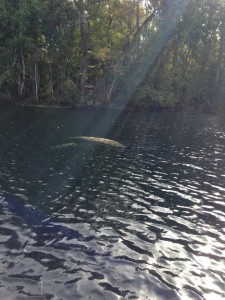
Manatees hanging out in Wakulla Springs.
Photo provided by Scott Jackson
So, statewide watercraft are still a big concern. Two of the three deaths in Escambia were boat related. The manatees tend to stay out of the boat channels, so it is recommend boaters remain in the navigable channels while heading to a destination and, when leaving the channel to reach that destination, go idle speed and have a lookout.
Manatees have actually benefitted the management of invasive hydrilla in the Wakulla River. FWC no longer has to treat it – the manatees are eating it all. Pensacola Bay is currently experiencing a bloom of epiphytic (attached) drift algae on the seagrass beds. Maybe, just maybe, the few manatees we see will consume as much algae they can.
I can understand the concern some boaters may have with manatees in the area. However, they do provide some benefits and are the highlight of the day for any local or visitor who may see them. We should welcome them and do what we can, within the law, to keep them safe. If you spot a manatee, please report it to the Dauphin Island Sea Lab hotline: 1-866-493-5803. Or email manatee@disl.org.

by Rick O'Connor | May 17, 2019
I am writing about this animal because, though it is rare to see them, our terrapin volunteers saw two this past week; and maybe you will too.
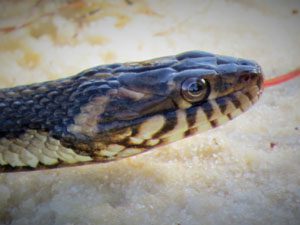
The round pupil and vertical jaw stripes indicate this is the nonvenomous Nerodia. Photo: Carole Tebay
The Gulf salt marsh snake is one of those, like the eastern coral snake, that is actually common – just rare to see. It is rare to see because (a) it lives in muddy salt marshes, where we rarely venture, and (b) it is mostly nocturnal – and even fewer of us venture into muddy salt marshes at night.
It is in the genus Nerodia, which includes the common water snakes like the banded water snake (Nerodia fasicata). It is a harmless nonvenomous snake. However, because of where it lives, it is often confused with a cottonmouth and is killed. A common name for this snake in Alabama is “bay moccasin”.
Their name is Nerodia clarkii, but it is a subspecies of this group – so the actual name is Nerodia clarkii clarkii. The other two subspecies are found in Florida. The Mangrove salt marsh snake (Nerodia clarkii compressicauda) is found from central Gulf coast of Florida, around the Keys to Indian River County on the Atlantic coast. The Atlantic salt marsh snake (Nerodia clarkii taeniata) has a very small range. Originally reported in Volusia, Brevard, and Indian River counties – due to the northern expansion of mangroves, it is believed to only be in Volusia County now. It is listed as THREATENED both federally and with the state. Our Gulf salt marsh snake is found from central Florida to Texas.
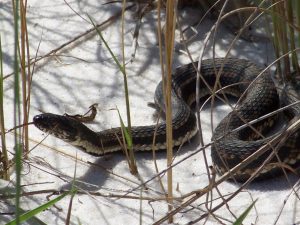
The nonvenomous Gulf Salt marsh Snake.
Photo: Molly O’Connor
It is a relatively small snake, only reaching a length of around 15-20 inches, though some have been reported at 30 inches. They possess two long yellowish-tan stripes running laterally the length of its body, the only species of Nerodia to do so. Again, they move at night feeding on small crabs, shrimp, frogs, and small fish. During daylight hours they hide beneath the wrack or other vegetation avoiding herons, egrets, and larger blue crabs. Lacking the needed glands, they cannot desalinate seawater the way sea turtles and terrapins can. All of their freshwater comes from their food and from rainfall.
They breed in the spring, possibly why we are seeing them now, and give live birth to about 10 young in midsummer. They are of moderate conservation concern in Alabama due to the loss of salt marsh. The loss of salt marsh habitat and rise of sea level are their major concerns at this point.
I do need to warn you, though it is a small, nonvenomous snake, they will bite. If bitten, soap and water will do the job. For me, and others, it is actually exciting to see them because of their reclusive nature. If you see one while exploring our intracoastal waters, know that you are not in any danger but rather lucky to see this “mystery of the marsh”.
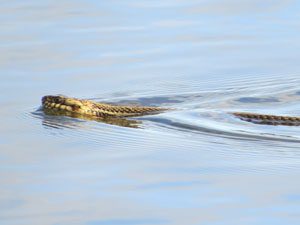
The Gulf Salt Marsh Snake swimming in a local marsh.
Photo: Carole Tebay
References
Gulf Salt Marsh Snake – Texas Parks and Recreation – https://tpwd.texas.gov/huntwild/wild/species/gulfsnake/.
iNaturalist – https://www.inaturalist.org/guide_taxa/776612.
Outdoor Alabama – Alabama Department of Conservation and Natural Resources – https://www.outdooralabama.com/non-venomous-snakes/gulf-saltmarsh-snake.
Atlantic Salt Marsh Snake – N.c.taeniata – U.S. Fish and Wildlife – https://www.fws.gov/northflorida/Species-Accounts/Atl-Salt-Marsh-Snake-2005.htm.


















